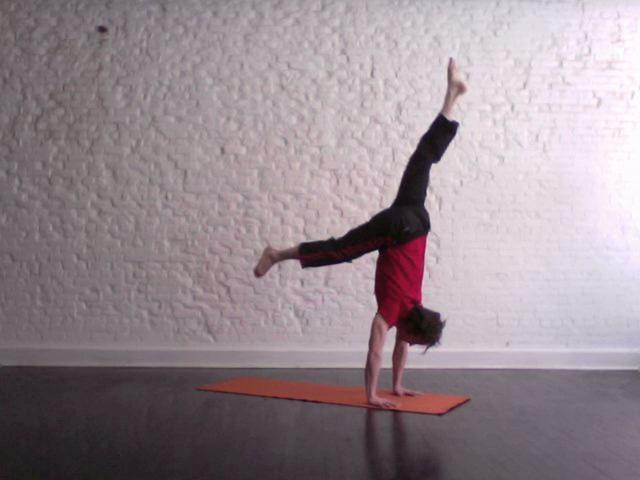The optimum goal for doing a Yoga hand stand is to build a strong foundation and work up to the full handstand. This prevents a lot of jumping, holding your breath and hoping for the best. Not to mention that it also prevents a lot of potential strains and injuries. It’s always best to take your time and make sure that you not only know what you’re doing, but that you’re strong enough to do it without risk of injury. It’s sort of pointless to do a handstand if you can only do it once and then you’re left out of commission for a while.
Starting Preparation
Before you rush right into the handstand, let’s take a moment to break it down from a beginner’s standpoint.
- Start your handstand off by getting into the downward dog position. Relax your knees a bit and really make sure that you are stretched out and loosened up. Remember to breath deep.
- Take a step forward towards your head with one leg, and then relax back into your other leg for a moment. Let your body stay stretched out and take your time. Use your breathing to help as you ease further into your yoga handstand.
- Taking a deep breath, extend your outstretched leg up into the air, as high as you can without lifting your second leg, and then slowly bring it down and tuck it into your chest. Keep taking deep cleansing breaths, and repeat this motion a few times.
- Switch legs, and repeat the same lifting stretch a few times with your other leg. This helps ready all of your muscles for the lift into the full handstand for yoga.
Lifting into the Full Yoga Hand stand
When you’re ready, place your hands under your shoulders in a downward doglike position. Take a deep breath; push off with one leg as you lift the other into the air above your body. It’s alright to have ‘soft legs’ at first. Practice makes perfect, and you should never over exert yourself or your muscles trying to get it exact with perfectly outstretched, straight legs the first time. The point is to build up your strength in the muscles used to perform the handstand for yoga. It’s important to remember that when lifting into the handstand, you shouldn’t ever jump or force it. Maintaining control of your muscles at all times is important.
Exiting the Handstand
Make sure that you leave the handstand with the same control and strength that you used to get into it. Try to keep yourself from crumpling into a pile on the floor, getting out of this pose with control is just as important as getting into it. Your safety is always important. Don’t ever rush in, or out, of anything too quickly when you’re attempting a handstand of any kind.


Comments
The control of that movement is exceptional, and the attention to building to a “lift off” rather than a kick up is cool.
For that, as with your book Logan, I would really like a bit more structured programming though: “when you can do movement A for X reps or Y time, move to movement B.” I can plan my practice sessions and play with movement all I like, but having a cue for when to move forward would be immensely helpful.
No less, that’s probably my favorite handstand tutorial vid in a while, because the entry is distinctly different from the hand balancers and gymnasts’ styles out there. Thanks for posting~
@Dunte H.: It’s an interesting way you can progress to a press where both legs are used. Yes, in the future I plan on doing step by step progressions towards those skills. I just need some more time to work on them myself 🙂
I really liked the idea of “How To” videos about Yoga!
Well done !